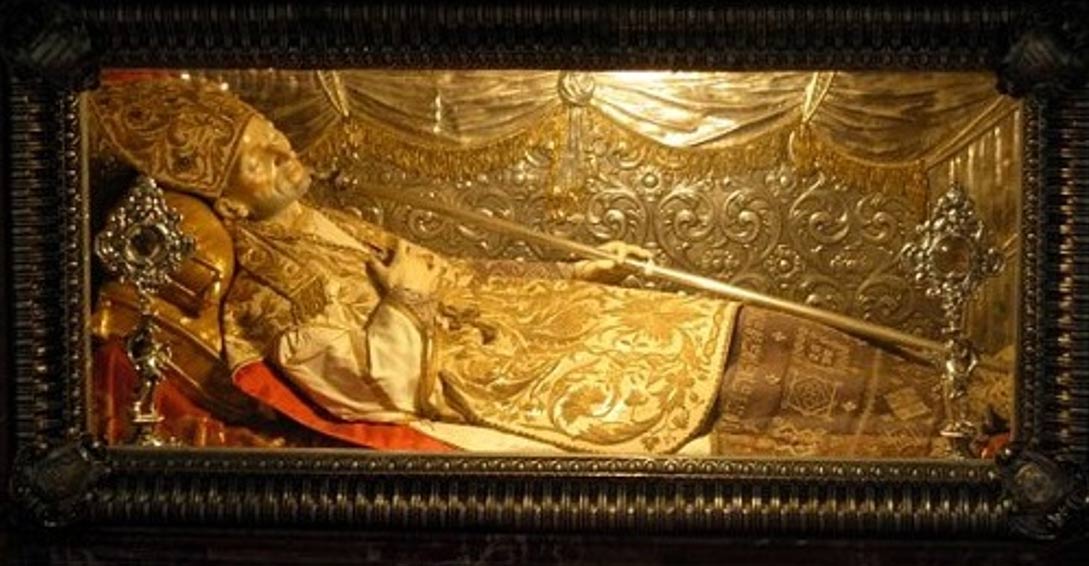
The Truth behind Christian Miraculous Preservation: How Mummies Become Incorruptible Saints
The Roman Catholic Church has given the title “saint” to thousands of real and legendary people, and even to some non-human entities, such as St. Michael the Archangel. The most comprehensive listing of saints is the Bibliotheca Sanctorum, which has eighteen volumes and lists more than 10,000 saints. However, there are many more than this in the Roman Catholic tradition; most of their names are now lost. And although the term initially referenced all baptized believers (hagioi in Greek), in modern times sainthood is an elaborate and expensive process, sometimes costing more than $500,000 in fees before the Church will grant someone such a status. This is how a saint is made:
An old canonical law stated that a potential candidate for sainthood must have been dead more than 50 years before the cause could begin, and although that is no longer official, it is rare for a cause to open for someone who has been dead for less time. People therefore initiate causes long after candidates’ deaths. When an individual or group wants someone named a saint, they begin raising money and publishing the candidate’s biographical accounts. Once enough promotion occurs, they ask a local bishop to begin the formal procedure. Called the Ordinary Process, adherents refer to the candidate as a “Servant of God” at this stage. First, all the potential candidate’s writings and teachings are examined for orthodoxy; if anything is found that counters the Roman Catholic Church’s statements − if the individual had a different opinion on some matters for example − the process cannot move forward. If there are no conflicts, the local bishop creates a tribunal, and witnesses for and against the candidate’s sanctity come to testify. During this process, the bishop must be sure that the individual is not the object of worship. As long as this is not the case and significant evidence for his or her holiness exists, the next phase in Rome begins. A canonical lawyer (trained and licensed by the Vatican) is hired, who presents gathered evidence to congregational judges.
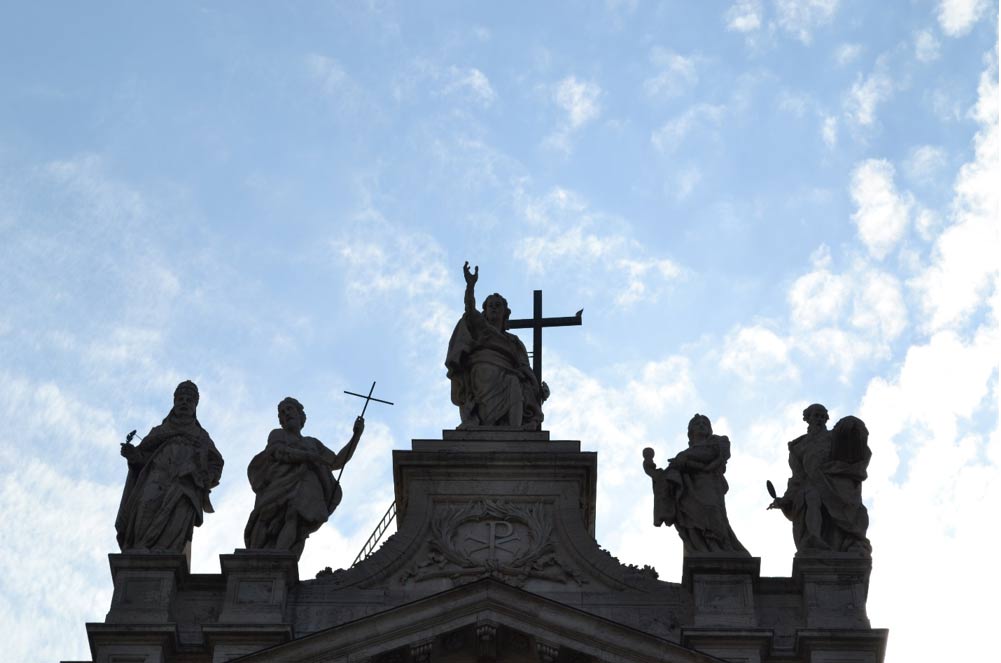
The saint-making process is to promulgate the faith and to curb unsanctioned cults. Photograph © Ken Jeremiah
Then, others take the role of Devil’s Advocate and write objections to the lawyer’s brief. He responds in writing, and then the process repeats. Sometimes, this exchange takes years. Once all opinions have been shared and an agreement reached, the cause moves forward and a positio is prepared: this is an extremely lengthy document (often more than 1,000 pages), which costs $13,000 for 100 copies (Woodward, 1996). Tipografia Guerra does all the Vatican’s printing, and despite the amazing cost, the Church requires the use of this company, as it is one of its partner corporations. One hundred copies of the positio are necessary because all cardinals, official prelates, and others involved in the process read it. If they reach an agreement that the cause should continue, they send a notification to the pope, and if he also agrees, he announces the cause’s official introduction, at which time the lawyer prepares another document called informatio, which provides information about the virtues and holiness of the candidate, who at this point the faithful can call a venerable.
Clergy members exhume and examine his or her body, and in the past, if they found that the body was preserved, they considered it a miracle and the cause gained a momentous boost forward. This was because a certain number of miracles were required for beatification (in which the Church allows its adherents to venerate the individual locally) and canonization (in which the Vatican allows his or her veneration by anyone worldwide). Each miracle needs an investigation, which also requires positiones that cost $4,000 each to print. Eventually, provided the miracles received confirmation, the candidate attained the title beatus (the male term) or beata (the feminine designation). At this point, the cause ended. It did not begin again until two more miracles occurred that the Church attributed to the Blessed. Even in modern times, this is the case. Once such miracles occur, they are both investigated and more positiones are written and printed, and provided they are judged actual miracles, the individual is named a Saint.
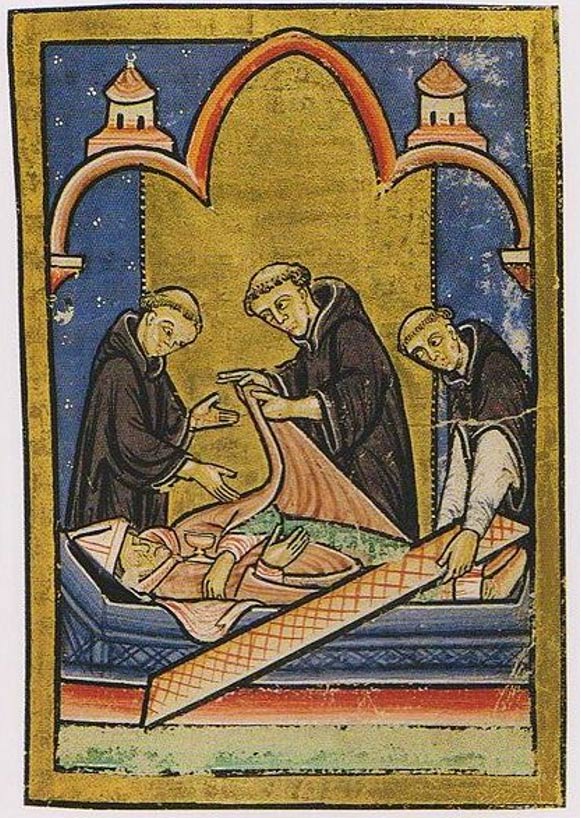
A miniature depicting the miracle where Cuthbert's body is discovered incorrupt. Public Domain
Believers think that saints’ bodies contain divine energy, and centuries ago, they slept in tombs or catacombs that contained saintly remains. They believed that the soul was composed of multiple aspects, (an idea adopted from the Egyptian faith, like many other concepts in Christianity), and while part of the saint’s soul was in heaven, the other part was with his or her earthly remains. For the same reason, people thought that the closer someone was buried to a saint, the easier it would be for him or her to enter heaven. Even today, belief in the miraculous capabilities of saints’ corpses has not waned, and bodies are in and around just about every church and cathedral in Europe. In Italy alone more than 300 bodies or body parts are displayed at Catholic sites. Many of them are said to have been miraculously preserved.
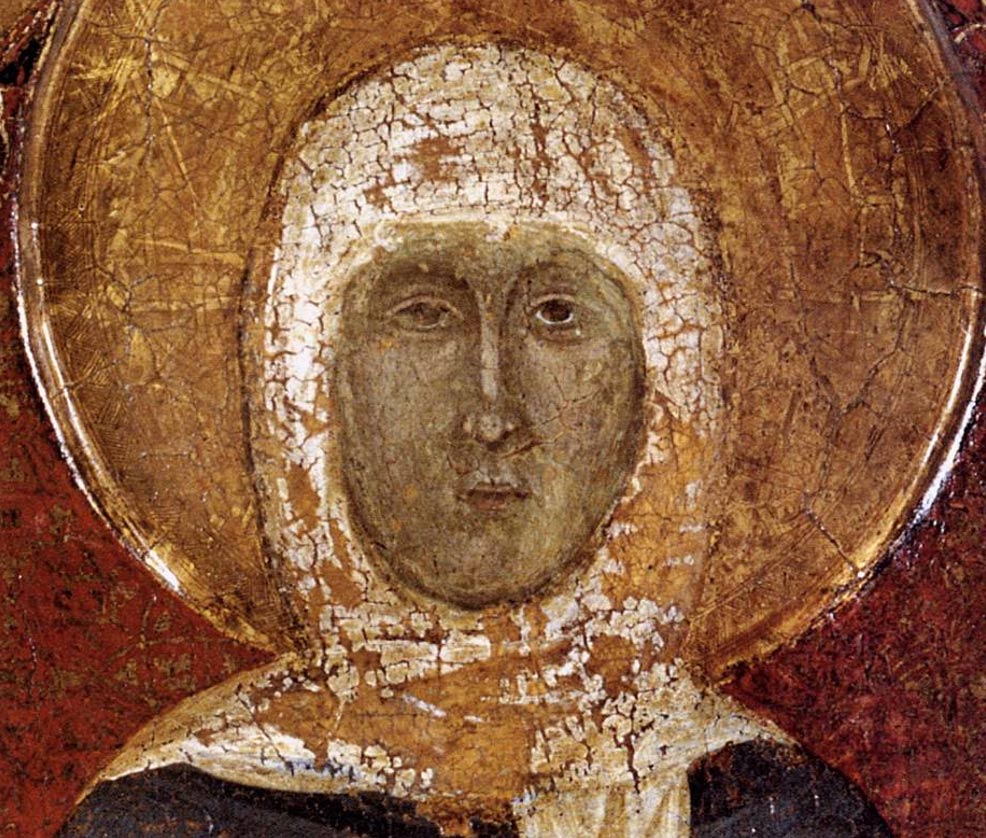
St. Margaret of Cortona. Public Domain
St. Margaret of Cortona (1247-1297) is one of them. According to Joan Carroll Cruz, she performed many miracles while she was alive, and she was so filled with divine grace that her body did not decay. “The body is light in color and dry, but completely whole. Even the eyes are full and all the nails of the feet and hands are still in place – truly a miraculous preservation which has existed for almost seven hundred years” (p. 94). When her body was unearthed for identification, it emitted a floral fragrance, which the clergy determined was the odor of sanctity: proof of divine involvement in her mummification. Seeing no signs of human intervention, they judged it a miracle. However, a recent investigation has determined that she had been intentionally mummified. There were large incision marks across her chest and abdomen. Her internal organs had been removed, and her body was thoroughly embalmed (Pringle, 2001). The term “embalm” literally translates to “treating with balms,” in other words, it was to infuse the body with a floral fragrance. Thus, the notion of an odor of sanctity is in fact the opposite: it is evidence of embalmment.
St. Clare of Montefalco (1286-1320) is another body that, upon exhumation, was determined to have been miraculously mummified. Cruz wrote, “Clad in exquisitely decorated robes with a veil covering the face and a crown adorning the head, the relic was found during its last examination in 1968 to be dry but perfectly flexible. The exposed hands of the saint, only slightly darker than normal, appear perfectly formed” (p. 105). Due to the alleged miracle of her preservation, the Church canonized her. Recently, a team of experts investigated the body, and they once again found large incision marks across her abdomen and chest. She too had been eviscerated and embalmed before burial (Pringle, 2001).
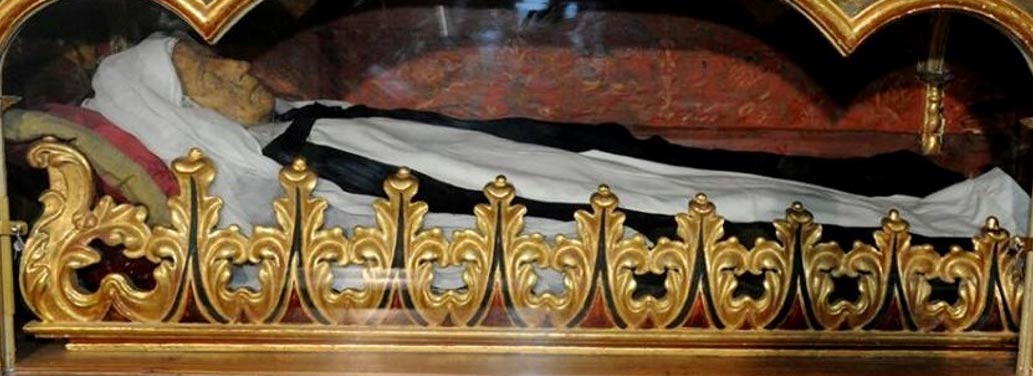
An Incorrupt body in the Monastery of St. Catherine of Siena (CC BY-SA 3.0)
The same is true with the body of the Blessed Margaret of Metola (1287-1320). Many wanted to open her canonization cause but she lacked the requisite miracles. In the 17th century, clergy members unearthed her and examined her remains. They stated that there were no signs that anyone had deliberately preserved her, so her canonization process began. Cruz described her remains: “The body of Bl. Margaret, which has never been embalmed, is dressed in a Dominican habit, and lies under the high altar of the Church of St. Domenico [in Castello]. The arms of the body are still flexible, the eyelashes are present, and the nails are in place on the hands and feet. The coloring of the body has darkened slightly and the skin is dry and somewhat hardened, but by all standards the preservation can be considered a remarkable condition, having endured for over 650 years” (p. 112). Of course, when experts recently examined the body, they again found large incision marks indicating that she was artificially preserved. This is also the case with numerous others, including St. Bernardino da Siena (1380-1444), St. Catherine of Siena (1347-1380), and St. Rita of Cascia (1381-1457).
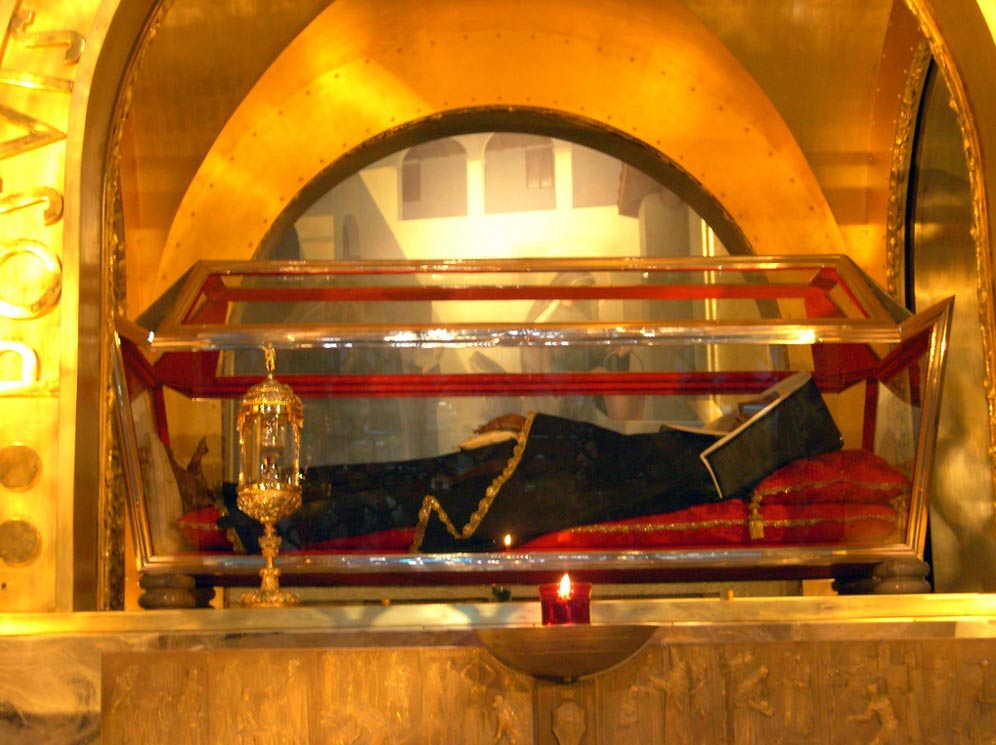
The body of Saint Rita of Cascia, found to be incorrupt by the Catholic Church. Public Domain
Others have been intentionally mummified in different ways. Popes and other high-ranking clergy members are always preserved after death, and embalmers seek to make the dead seem as lifelike as possible for as long as possible. To accomplish this aim, noted embalmers have devised various methods. Certain embalming solutions can be injected into the body without having to drain the blood, and such preservation results in bodies that can bleed long after death if they are cut or injured in some way (Jeremiah, 2014). Dr. Alberto Salafia, for example, preserved the body of Cardinal Michaelangelo Celestia by injecting 15 gallons of embalming solution into his carotid artery (Quigley, 1998). The popliteal artery (found behind the knee) can also be used, and this was perhaps a favorite technique used by the clergy to hide intentional embalmment. St. Mary Magdalen de’ Pazzi (1566-1607) is one individual who was likely secretly embalmed in this manner. She smelled of flowers, which is clear evidence of embalmment, and a liquid dripped from small pin holes in the back of her knees for years. Minima wrote, “From the knees of the sacred body trickled a liquid of exquisite scent. It looked like oil, but it was not. It was examined [by nuns], but its nature could not be ascertained” (p. 326). Nuns, not understanding what it was, collected the liquid in jars, believing it was some sort of miracle (Jeremiah, 2012).
One of the most celebrated intentionally mummified bodies is not that of a saint, but it is in Italy, in the Capuchin’s catacombs in Palermo, Sicily. It is the body of Rosalia Lombardo, who died in 1920 when she was only 2 years old. Her face is still rosy red, and she looks as though she is still alive, only sleeping. Her skin is flexible. Dr. Salafia, who also mummified various clergy members, preserved her using a mixture of formalin, glycerin, zinc, alcohol, and salicylic acids.
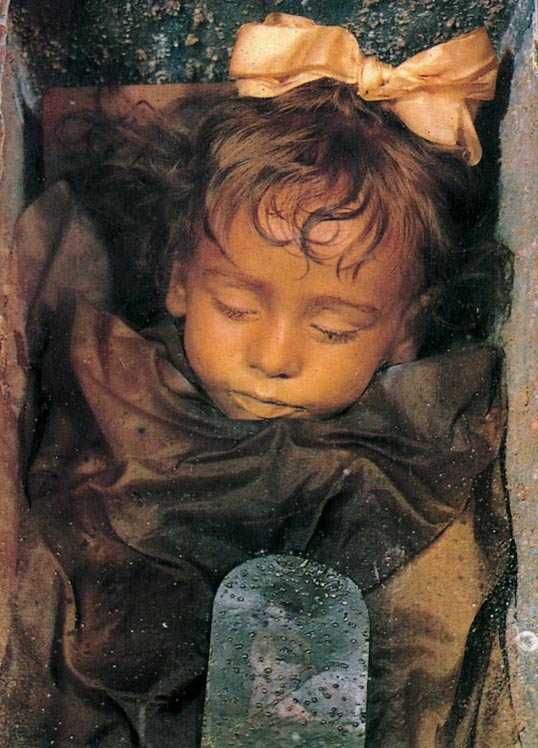
The mummy of the child Rosalia Lombardo (1918-1920) exposed in the cemetery of the Capuchins in Palermo. Public Domain
Other embalmers, including Salafia’s teacher Dr. Tranchina from Naples, advocated the use of arsenic in their solutions, as arsenic preserved the body’s coloring. The face would remain reddish and lifelike for centuries (Jeremiah, 2014). Still others made use of osmosis in their embalming procedures: this was to eliminate any signs of intentional preservation. After the bodies of clergy members were preserved, they were buried, and since canonization procedures were not allowed to commence until more than 50 years after potential candidates had died, often the embalmers were no longer alive when the potential saint was unearthed for identification purposes. Hence, no one came forward to announce that he or she had embalmed the candidate.
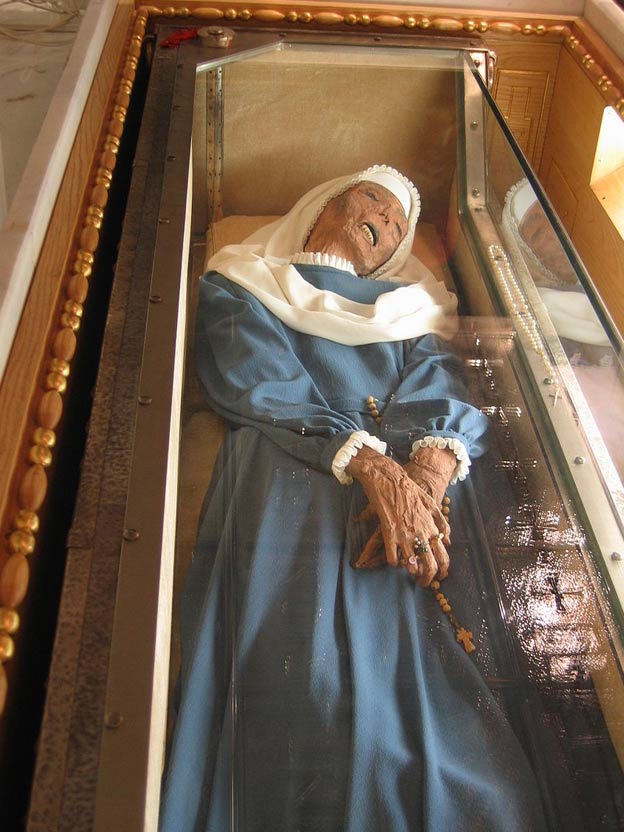
The body of Saint Virginia Centurione, found to be incorrupt by the Catholic Church. Public Domain
Examined by clergy members unknowledgeable about methods of intentional preservation, they interpreted the rosy, lifelike color and flexible skin as miracles, just as they interpreted the floral fragrance such bodies emitted. When a centuries-old body bled or leaked other fragrant liquids, they too were misinterpreted as holy signs, rather than what they really are: indications that such bodies were intentionally mummified. However, no matter how much evidence is unearthed, some Catholics hold steadfastly onto their belief that such bodies are still miraculous. They call them Incorruptibles, and they claim that such bodies have attributes that other naturally and artificially mummified bodies do not. Nevertheless, when asked to describe these attributes, they say things like “flexible and lifelike skin”, “a reddish complexion”, and an accompanying “divine fragrance”, and in modern times, it is clear that such qualities are telltale signs of intentional mummification. Giuseppe Fallica (2009) claims that science cannot explain such bodies and they therefore cannot be classified as natural mummies; additionally, since there is no sign of human intervention, they cannot be classified as artificially preserved remains.
However, all of the bodies that have been recently examined can be explained. They all had unmistakable signs of human intervention in the preservative process. Perhaps unsupported justifications for the continued belief in the phenomenon called incorruptibility are just lingering beliefs that people do not wish to relinquish. As for the Church, however, due to scientific explanations for the extant bodies’ mummification, it no longer views bodily preservation as miraculous: today, a body that fails to decay cannot be counted as a miracle, and it will no longer vault a potential candidate toward sainthood.
Check out Ken’s website www.kenjeremiah.com, and follow him on Twitter @drkenjeremiah
Featured image: The body of Saint Alphonse Mary of Liguori, found to be incorrupt by the Catholic Church. Public Domain
References:
Cruz, J. (1977). The Incorruptibles: A Study of the Incorruption of Bodies of various Catholic Saints and Beati. Rockford, IL: Tan.
Fallica, G. (2009). Il miracolo dei corpi incorrotti in 2000 anni di storia della Chiesa. [The miracle of incorruptible bodies in 2000 years of Church history]. Italy: Edizioni Segno.
Jeremiah, K. (2014). Eternal Remains. Sarasota, FL: First Edition Designs.
Jeremiah, K. (2012). Christian Mummification: An Interpretive History of the Preservation of Saints, Martyrs, and Others. Jefferson, NC: McFarland & Co., Inc.
Minima, M. (1958). Seraph among Angels: The Life of St. Mary Magdalene de’ Pazzi. Chicago: The Carmelite Press.
Pringle, H. (2001). The Mummy Congress: Science, Obsession, and the Everlasting Dead. New York: Hyperion.
Quigley, C. (2006). Modern Mummies: The preservation of the human body in the twentieth century. London: McFarland & Company, Inc.
Woodward, K. (1996). Making Saints: How the Catholic Church Determines Who Becomes a Saint, Who Doesn’t, and Why. New York: Simon and Schuster.